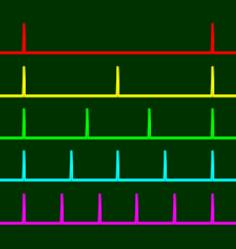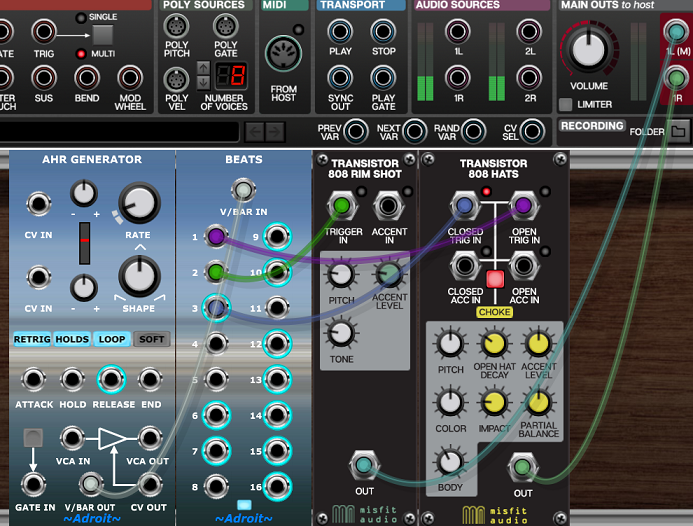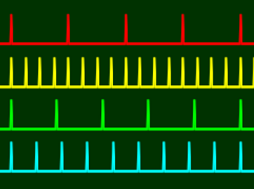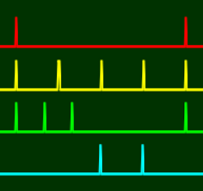
This simple module divides a bar up into beats. Although it looks similar to a Time Splitter (because it has a V/BAR IN socket), its outputs are standard trigger signals rather than V/Bar signals. So it can be used to trigger things like envelope generators, drum modules or conventional step sequencers.
The 1 socket outputs a trigger once per bar. The 2 socket outputs a trigger twice per bar. The 3 socket outputs a trigger three times per bar and so on.
All divisions are equally spaced across the bar.
The CV Watcher traces below show the first five outputs…

A related LSSP module is Triggers. Use this instead if you want individual triggers at specific steps in a bar.
Table of Contents
Applications
Sometimes all one might need is an 1/8th note trigger that lasts for a couple of bars and using a Rhythm Sequencer for such a simple task is overkill. So for such an application this module can be used instead with the required signal simply patched from the 8 socket with the two bar period being programmed into a Song Part module that provides the V/Bar signal for the Beats module.
In another scenario one might want a simple triplet rhythm than runs at 12 beats per bar. You could use a Groove module and a Rhythm Sequencer to do this and have fine-tuned control over all kinds of details but that might be like sending in a cruise liner when all that’s needed is a small rowing boat.
Other applications for the Beats module include experimenting with polyrhythms. The patch below shows an extremely simple example that sounds surprisingly effective even though there’s almost nothing going on.

It’s not every day that you will find a use for things like 1/15th notes but the option is there. Really esoteric timing ratios generally sound awful at fast tempos but can have a certain magical quality at very slow tempos – giving things a random feel but with everything still being100% determinate.
In such a scenario rather than running the entire song at a slow tempo the V/Bar signal being fed to a Beats module could be modified by a Time Flow Changer module set to slow down time to say 1/4 its normal rate. One could then for instance explore the strange interaction between a beat that triggers 5 times over four bars with one that triggers 9 times over four bars, while the rest of the song proceeds at a steady 4 beats per bar…

Time Flow Changer is also useful for speeding up the flow of time. In the patch below the Time Flow Changer doubles the V/Bar signal fed to the Time Split 2 module. Therefore the two Beats modules run alternately for half a bar each. The one on the left is used to trigger the low conga three times in the first half of the bar, while the one on the right triggers the mid conga twice in the second half of the bar. This produces a Son Clave 3-2 Latin rhythm but the setup can easily be adapted to produce a range of complex patterns.

The CV Watcher traces below show the Song Control BAR OUT signal in red, the Song Control BEAT OUT signal in yellow, the 3 output from the left -hand Beats module in green and the 2 output from the right-hand Beats module in cyan…

Flashing lights
Each of the outputs has an illuminated ring that flashes when the output trigger fires. This can be very useful for seeing what’s going on (especially when working with polyrhythms at very low tempos) but can also be rather annoying. So there’s a little button at the bottom of the module just above the ~Adroit~ logo that enables you to switch all of them off except the slowest one which fires just once per bar.
Comparison with a clock divider
One might think of this module as being rather like a conventional clock divider that has multiple outputs available simultaneously. Although it’s driven by V/Bar sequencing and can do time divisions that aren’t possible using clocks.
As an example of this last point – say you want to produce a regular trigger that fires five times per bar. You might have been inspired by some of the many brilliant compositions written in 5/4 time or just want to explore beyond the rigid boundaries of 4/4.
The sync signal in Voltage Modular runs at 96 PPQN.
96 pulses per quarter note means that there are 384 clock pulses per bar (96 times 4).
Numbers like 96 and 48 are used in clock based systems because they are easily divisible by common numbers like 2, 3, 4, 6, 8, 12 and 16.
Returning to our example – a 1/5th note by definition lasts 1/5th of a bar and so ought to last 384 divided by 5 clock pulses. But that’s 76.8 clocks per beat and so simply isn’t available from a clock divider that counts clock pulses. The nearest you could get would be 77 pulses per beat which results in approximately 4.987 beats per bar. Alternatively you could divide by 76 and end up with approximately 5.053 beats per bar. Either way the beats would not be exactly spaced and you’d also have to arrange for the clock divider to be reset once per bar to stop everything from sliding out of sync over a number of bars.
In contrast, using V/Bar a 1/5th note is merely a voltage difference of 1/5th of a volt and everything is super simple and sample accurate due to 64 bit precision.
64 bit floating-point arithmetic is accurate to 15 decimal places.
Of course none of this prevents you from working in 5/4 time with a conventional clock based system without such complications. You can simply pretend that PPQN means pulses per fifth note, set sequence lengths to multiples of 5 and work on the assumption that there are 480 (96 times 5) rather than 384 clock pulses per bar. But this workaround can become extremely tricky if you want to deal with time-signature changes or complex polyrhythms.
Also as LSSP Song Control assumes that the sync signal is fixed at 96 pulses per quarter note then if you use a clock divider that assumes there are 96 pulses per fifth note then building hybrid patches that use clock dividers and V/Bar will result in massive timing problems.
The solution is quite simple – use Song Control for master timing and use the Beats module rather than a clock divider to generate your clock signals. This way the LSSP part of a patch has regular V/Bar timing control and the conventionally clocked part of a patch has accurate clock signals that are no longer constrained by having to be generated as whole number divisions of 96 PPQN. Everything becomes really straightforward on both a conceptual and practical level.
One final word…
Let’s imagine that you have a legacy patch that works with a 96 PPQN master clock but because it explores 7/4 time it was built on the assumption that there are 7 quarter notes per bar. So it’s expecting to receive 672 clocks per bar (96 times 7). It’s an amazing patch but you can’t remember how on earth all the intricate timing works. But you want to integrate this patch into the world of LSSP to add some extra elements.
So how do we create a clock that fires 672 times per bar? The answer is to use a Time Flow Changer to amplify a 1 volt per bar signal to a 96 volts per bar signal, then feed this signal to a Beats module and take the clock from the Beat module’s 7 output.
The result is a signal producing exactly 672 (96 times 7) triggers per bar.
Availability
The Beats module is only available as part of LSSP XL.